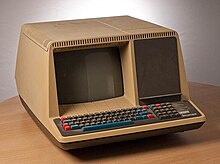VT52

The VT50 was a CRT-based computer terminal produced by Digital Equipment Corporation introduced in July 1974. It provided a display with 12 rows and 80 columns of upper-case text, and used an expanded set of control characters and forward-only scrolling based on the earlier VT05. The VT50 was sold only for a short period before it was replaced by the VT52 in September 1975.[1] The VT52 provided a screen of 24 rows and 80 columns of text and supported all 95 ASCII characters as well as 32 graphics characters, bi-directional scrolling, and an expanded control character system.
Both models supported asynchronous communication at baud rates up to 9600 bits per second and did not require any fill characters. The terminal also introduced a separate function keypad that allowed "Gold Key" editing (as exemplified by WPS-8, KED, and EDT). They also offered an optional hard-copy device called an electrolytic copier, which fit into the blank panel on the right side of the display. This device was able to print, scan-line by scan-line, an exact replica of the screen onto a roll of paper that was saturated with salty water. It did this by electroplating metal from an electrode into the paper. While it did an admirable job of capturing the contents of the screen, the output of the copier had an unfortunate resemblance to wet toilet tissue.[2][3] Digital patented the innovation of having a single character generator provide the text font for both screen and copier.
Stages of development
The VT50 was the first terminal Digital produced in this cabinet. It provided only 12 lines of text (leading some users to object to the "double-spacing") and, like the predecessor VT05, did not support lowercase letters. Computer users of that era used coding in the rare instance that they needed lowercase text. Opinion differed as to whether the VT50 was to be a dry run for the engineers or a lucrative product. The introduction of the VT52, and its support of lowercase text on the screen and scrolling both upward and downward, enabled WYSIWYG ("What you see is what you get") text editing.
The large size of the cabinet was deliberate, to avoid a cooling fan. The two circuit boards with processor and memory at the base of the terminal, and a single board with power-supply and monitor electronics at the rear, were cooled by convection. The large, flat top of the terminal frequently accommodated large volumes of DEC documentation.
These terminals used a primitive, custom central processing unit built from small-scale-integration integrated circuits. It was so basic that addition and subtraction could only be done by repeatedly incrementing or decrementing two registers, and only while a raster scan was not in progress. Moreover, the time taken by such a program loop had to be nearly constant, or text lower on the screen would be displayed in the wrong place during that refresh. Display of text was not done under microprogram control; the microprogram activated separate hardware to take exclusive access to screen memory and waited until a line of pixels was complete.
The VT52 became a platform on which Digital built several related devices. The VT55 incorporated an add-on graphics system that was capable of displaying two mathematical functions or histograms.
The VT61 and VT62 were block-mode terminals. The VT62 was to be used in conjunction with TRAX, a transaction processing operating system on high-end PDP-11's. They used the same cabinet but had a more complete custom processor. Application-specific behavior was coded in separate PROM memory, using a separate instruction code that the processor interpreted. This unpublished language was to be used to easily develop additional models specific to single Digital marketing organizations. These terminals synthesized a "tock" sound on a speaker for feedback when a key was pressed, whereas the VT5x activated a relay. The relay was also used as a buzzer to sound the bell character, producing a sound that "has been compared to the sound of a '52 Chevy stripping its gears."[4] Though the keyboards were identical, VT6x users admired the superior "feel."
The VT78 added to the VT52 a single-chip PDP-8 processor, on which was programmed WPS-8, Digital's word processing system. This model was not a terminal to use to communicate with a computer, but a complete, stand-alone system. Whereas the VT50 was developed in the era before it was common to apply computers to text, the VT78 was a product designed for that application.
The VT52 family was followed by the much more sophisticated VT100.
References
- ^ Digital computing timeline
- ^ http://alt.nntp2http.com/sys/pdp11/2007/06/7fe45444f712cbc6e132f37362dc99cc.html
- ^ http://www.mail-archive.com/linux-advocacy@senator-bedfellow.mit.edu/msg02082.html
- ^ Raymond, Eric S., ed. (1996). The new hacker's dictionary. MIT Press. p. 186. ISBN 978-0-262-68092-9.
